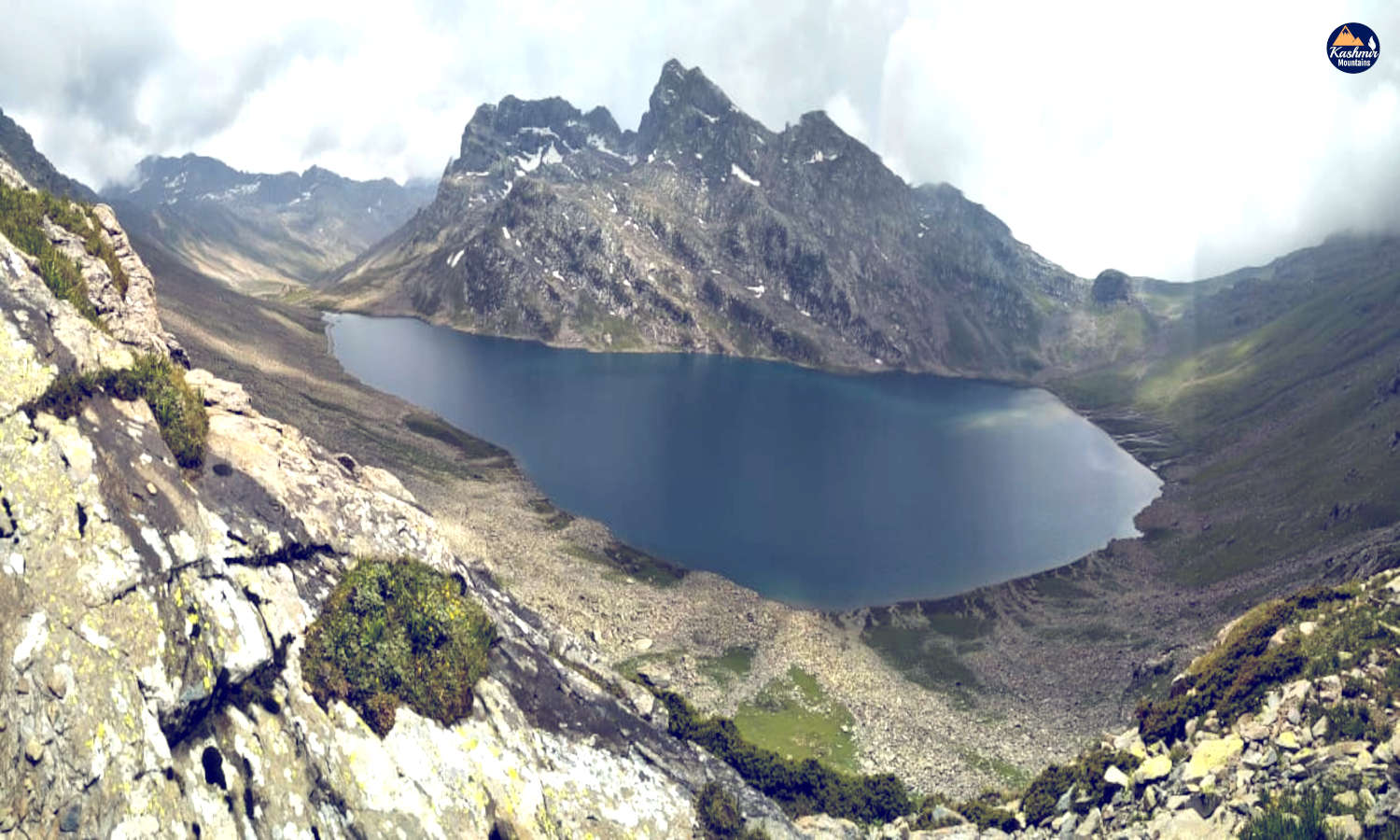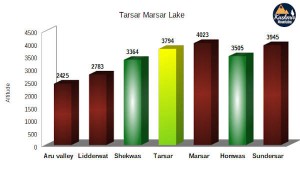

The Tarsar Marsar Lake Trek stands out as one of the most popular treks in the Kashmir Valley. This trek encompasses a journey to the two stunning twin lakes, which share an almond shape and are notable for their beauty. Surrounded by the majestic peaks of the Kolohai Glacier, Tarsar and Marsar Lakes create a picturesque setting.
As you follow the trail, lush meadows, crystal-clear rivers, and mesmerizing mountains and valleys unfold before you. Moreover, you can camp next to the emerald-blue lake of Tarsar, making it the best alternative to the Kashmir Great Lakes Trek.
The enchanting Tarsar Lake and Sundersar Lake are the first highlights along the trail. One of the best features of this trek is that you can set up camp right next to these serene blue lakes, which provide some of the most breathtaking views in the region.
Next, the trek leads you to Marsar Lake. The dramatic views it offers are often veiled in clouds, adding a sense of mystery to your experience. Although Marsar Lake sits at a lower altitude, you can still admire its beauty from above. Furthermore, the clouds change daily, making each visit unique. To capture these incredible views, you should arrive early.
 First, the tranquility of the surroundings enhances the charm of the trek. This expedition offers a peaceful and nurturing journey through stunning landscapes. From the highest ridges on this scenic trek, you can enjoy panoramic views of the entire area.
First, the tranquility of the surroundings enhances the charm of the trek. This expedition offers a peaceful and nurturing journey through stunning landscapes. From the highest ridges on this scenic trek, you can enjoy panoramic views of the entire area.
Additionally, the trek is accessible to anyone who enjoys the outdoors. It reaches a maximum elevation of 13,000 feet, beginning with a brief ascent before leading into a dense forest. As you walk along the trail, the calming sounds of the Lidder River and the chirping of birds accompany you through the pine forest. After about 5 kilometers, the trail merges with a vast meadow, where the Lidder River runs alongside the wavy terrain. When you reach the Lidderwat campsite, you will find that the walk has been pleasant and easy.
Srinagar city is known as the Venice of the East for its unique aquatic culture. The Numerous Lakes and Rivers are all interconnected through canal ways giving rise to a unique city known for its Lavish Houseboats which are intricately designed of pine wood. You will be hosted in these houseboats which are found nowhere else, Once you Arrive you will be taken for a ride around the lake Exploring floating vegetable gardens and islands on the Dal Lake. Overnight at Houseboat.
Brief Overview of the Day
Srinagar to Aru Valley 107 km Drive from Srinagar up to Aru valley via Pahalgam 3 hours drive.
Today we will start walking upstream towards Lidderwat. Soon we will enter a thick forest of conifer trees and you will be able to see Aru Valley down at a distance. After crossing the forest we will reach Nandekai Village which is mostly inhabited by seasonal migrating shepherds. The trek is an easy trail with a gradual ascent.
As we keep walking further we will come across a log bridge and we can rest here for a while before continuing our journey to Lidderwat which is about two hours away from this point. We will enter another wooded area which opens up at the meadows of Lidderwat village. We will be camping near the river for the night.
Brief Overview of the Day
The destination for today is Shekwas. As we start walking away from the Lidder river, we will enter a pine forest that is not very thick and has a number of clearings throughout the trail. There will be multiple clear water streams crossing our path so we don’t have to worry about the water supplies for today. As we keep walking we will enter another migrant village known as Homwas. Crossing a log bridge, we will enter Shekwas village. The meadows at this location are breathtaking which extends to a distance as far as eyes can see. We will trek a further higher from the village to reach our camping site.
Brief Overview of the Day
The beautiful trail to Marsar starts with grassy meadows of Shekwas, a beautiful natural lawn. After walking on the grass for some time, we will cross over a hill to reach the first ridge. It will take around 3 hours from here and over a few more ridges to reach Tarsar. The view of the lake will keep unfolding magically before your eyes as we keep crossing the subsequent ridges.
On the final part of the trail, we will come across a stream which we will cross by walking over bounders before finally stepping into the grassland around Tarsar Lake. This is our camping site for today and you can take your time to explore the beautiful area around the lake.
Brief Overview of the Day
We will wake up early and start walking to the adjacent valley of Sundersar via Tarsar Pass. This part of the trail is a bit difficult as the ascent to the pass is steep but it becomes an easy gentle walk down to Sundersar. The trail will take you through a high exit pass, grasslands, and through places filled with wildflowers. Once we reach the valley, we will trek over a trail filled with boulders along the stream to reach Sundersar lake and camp here for the night.
Brief Overview of the Day
We will start climbing up higher through the Marsar ridge. The trek is of moderate difficulty as you will find yourself walking over the boulders with melting ice which makes it difficult to walk. Watch your step carefully and follow your trek leader to avoid injuries. After crossing this area filled with boulders, we will start descending to a flat trail with many water streams crossing our way. The lake is located in a similar setting as the previous one. You will be able to see the snow melting from cliffs and feeding water to the lake.
After spending some time at Marsar Lake, we will make our way back to Sundersar Valley and from there we will walk to Homwas. Night stay will be in camps at Homwas.
Brief Overview of the Day
Today you take the same route that you had taken at the beginning of the trek via Lidderwat. The trail goes downhill and it is a quick descent. It will take you 2 hours from Homwas to Lidderwat. The beauty of this part of your trek is that you will get to see all of those views that you had initially missed. The shrinking Kolahoi glacier is one of these sights. You will see the pine forests of Lidderwat that you had seen on day one of your treks in a whole new light. After getting some rest at Lidderwat, you head for Aru. It is a 10 km walk from Lidderwat to Aru. This takes around 4 hours to cover. Stop for lunch en-route, you are expected to reach Aru by 4 in the evening. Vehicles will be arranged from Aru to Srinagar. You will reach Srinagar between 7-8 pm overnight stay Houseboat.
After breakfast at houseboat. Our representative will drop you at Srinagar Airport.
It is good to make your booking two months prior in advance. In the event of cancellation of any trek/adventure activity due to any reasons, it is compulsory to notify us in writing. Cancellation charges will only be effective from the date we receive your request in writing.
If the trek is cancelled by us due to any reason (heavy snowfall, rainfall, natural disaster etc.) then the refund would not be initiated but you can go on the same trek another year. Kashmir Mountain Adventures Family is always with you, Thanks The cancellation charges are as follows: